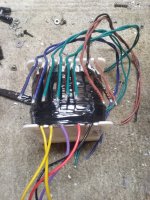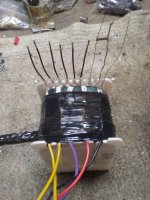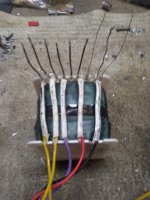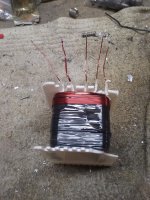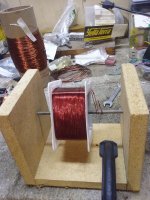Ordered, received, then had to deal w/ this iron albatross... Original Spec's link below-
https://www.diyaudio.com/community/threads/modifying-a-pt.392248/
Listed this mishap on Ebay in hopes of finding.. maybe.. someone that had 220/230 vac their US/Canada living room. Listing failed, not surprised-
Can't send this back- China too far- have to own it..
So then-
Step 1- The unwind... pic #'s 1-5 are bit confusing, but tried to illustrate sequence from outside to in-
#1- 230 V Primary- 20 ga- 553 count
#2- 6.3 V 4A filament #1 -16ga- 14 count
#3- 6.3 V 4A filament #2 -16ga- 14 count
#4- 720V CT secondary- 26ga... too many- lost track- another path deemed
#5- 5 V 4A rectifier- 16ga- 12 count
Step 2-
A- Rewound primary to 2 equal sections for parallel 115-120V (same 20ga) -See pic A
Next is received spool of 23ga today for target 330V single side secondary- what count DIY panel?
Jim
ps, filament and other low voltage windings next of discussion
https://www.diyaudio.com/community/threads/modifying-a-pt.392248/
Listed this mishap on Ebay in hopes of finding.. maybe.. someone that had 220/230 vac their US/Canada living room. Listing failed, not surprised-
Can't send this back- China too far- have to own it..
So then-
Step 1- The unwind... pic #'s 1-5 are bit confusing, but tried to illustrate sequence from outside to in-
#1- 230 V Primary- 20 ga- 553 count
#2- 6.3 V 4A filament #1 -16ga- 14 count
#3- 6.3 V 4A filament #2 -16ga- 14 count
#4- 720V CT secondary- 26ga... too many- lost track- another path deemed
#5- 5 V 4A rectifier- 16ga- 12 count
Step 2-
A- Rewound primary to 2 equal sections for parallel 115-120V (same 20ga) -See pic A
Next is received spool of 23ga today for target 330V single side secondary- what count DIY panel?
Jim
ps, filament and other low voltage windings next of discussion
Attachments
Last edited:
With primary divided and dually wound to modify for 115V usage-filament and other low voltage windings next of discussion
Then which group should be wound next? Filament windings or B+? Does winding closer to the core prioritize flux transmission?
I think yes, since flux density is less as distance from the core/primary winding increases...
If so, which voltage stability is more important?
Jim
Last edited:
